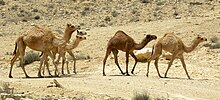Camelus dromedarius
The dromedary or Arabian camel (Camelus dromedarius) is a species of artiodactyl mammal of the Camelidae family It is similar to the Bactrian camel (Camelus bactrianus), from which it differs by its generally shorter fur, less robust body, and the presence of one hump instead of two. No subspecies recognized.
Etymology
The term "dromedary" comes from Late Latin dromedarius from the Greek word dromas, δρομάς (genitive, dromas, δρομάδος), meaning "corridor", used in Greek in the combination δρομάς κάμηλος (dromas kamelos), literally "running camel", in reference to its famous speed (see camel race). This word is late; for example the first recorded use in English of "dromedary" occurs in the 14th century.
On the other hand, the word "camel", which is more general and can refer to the dromedary or to the conspecific Bactrian, derives from the Latin word camelus, from the Greek kamēlos, which would come from some ancient Semitic language; compare Hebrew gāmāl or Arabic ǧamal. The name of the Phoenician letter gamal (𐤂), from which the Greek gamma (Γ) and the Latin ce (C) come, means "camel" so it has sometimes been speculated that the letter represented this animal.
Difference between camel and dromedary
The word "dromedary" is a cultism used specifically for the Arabian camel, while "camel" is the colloquial word used for the three extant species of the genus Camelus as well as other extinct ones. However, in the definitions of dromedary and camel in the Dictionary of the Royal Spanish Academy, the dromedary is stripped of the category of camel, noting the number of humps; an academicism that collides with biology, etymology and popular usage.
Features
Like its Asian cousin, it is a hornless tilopod, with the nostrils forming oblique slits, the upper lip is split extensible and separately movable, the abdomen elevated, and long, slender legs with hooves. Their anatomy shows all kinds of adaptations to life in the hot, sandy deserts where they live: their knees and ankles have calluses that make them more resistant to the heat of the sand when they sit; Their long, fine eyelashes keep their eyes safe from sand getting into them, and their hump maintains a fat deposit with which they can nourish themselves and even generate water if necessary. Their ability to resist dehydration has made them very valuable animals in the desert. The dromedary can drink up to one hundred and fifty liters of water in a very short time.
Genetics and hybrids
The dromedary has 74 diploid chromosomes, like other camelids. The autosomes consist of five small to medium-sized metacentric and submetacentric pairs. The X chromosome is the largest of the metacentric and submetacentric group. There are 31 acrocentric pairs. The karyotype of the dromedary is similar to that of the Bactrian camel.
Hybridization of camels began in the 1st millennium BC. For about a thousand years, Bactrian camels and dromedaries have bred successfully in regions where they are sympatric to form hybrids with a long, slightly crooked hump or two humps. one small and one large. These hybrids are larger and stronger than their parents, and can carry greater loads. A cross between a first generation hybrid female and a male Bactrian camel can also produce a hybrid. Hybrids of other combinations tend to be moody or small.
Distribution and history
Dromedaries originate from the Arabian peninsula, although they have been introduced by man to many places and cases in which these animals have escaped and formed semi-wild populations are not rare. As an example, we can mention the camels of the Sahara, introduced for the first time in Roman times, and those of Australia, which arrived there during the English explorations of the 18th century, from specimens transported from the Canary Islands. Use The use of this animal as the engine of work in agricultural tasks has been common in said archipelago until recent industrialization, generating its own terms such as Guelf, to define the breeding of the dromedary.
An engraving from Aswan is dated to the 6th Dynasty of Egypt, with the image of a dromedary and its rider, which would deny the arrival of this animal to the Sahara desert from the East in Christian times.
Numerous literary, epigraphic and papyrological references to the presence of the dromedarii in the Roman armies have been preserved, and it is estimated that the first unit that included them was formed in the time of Emperor Trajan, although the Romans themselves had long known of its use by allies and enemies.
Introduction in Australia
The dromedary was introduced by man to Australia during the 19th century.
Most of the Australian specimens come from the Canary Islands (Lanzarote and Fuerteventura), imported for transport purposes before the appearance of the internal combustion engine.
With the advent of trucks and automobiles in the 1920s, the dromedary lost its place in the Australian economy and large numbers were abandoned in the desert.
The population of Australian dromedaries has naturalized and is increasing geometrically, doubling in number every eight to twelve years. In 2010 Australian government sources estimated the population at one million head.
Contenido relacionado
Ravinder N. Maini
Onychopetalum
Megafauna


